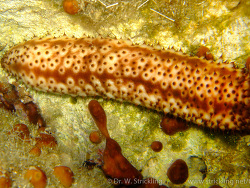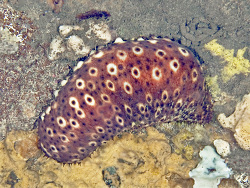Info
Holothuria (Platyperona) sanctori Delle Chiaje, 1823
The variable sea cucumber is one of the most abundant sea cucumbers in the Mediterranean, the same is true for Holothuria (Roweothuria) poli Delle Chiaje, 1824.
Holothuria (sea cucumbers) are diverse organisms that are considered key organisms in marine ecosystems because of their great ecological importance.
They strongly influence the physico-chemical processes of soft-bottom and reef ecosystems through their benthic bioturbation activity, and their excretion of inorganic nitrogen and phosphorus, which increases the productivity of the benthic biota.
Economically, sea cucumbers are known for their aphrodisiac properties,
However, for human nutrition, sea cucumbers are also considered a rich source of proteins and of bioactive compounds such as chondroitin sulfate and mucopolysaccharides.
They also contain vitamin A, thiamine, riboflavin, niacin, calcium, iron, magnesium and zinc.
Sea cucumber extracts have anticancer, antimicrobial, and antioxidant properties and support wound healing.
Overfishing of sea cucumber stocks in the Indo-Pacific region has led to increased catches of sea cucumbers of holothurial species in the Mediterranean region, which were not previously considered economically
important.
The variable sea cucumber is exploited in many Mediterranean countries for commercial purposes and for its saponins, and in aquaculture it has an important role in the management of multitrophic aquaculture systems by absorbing high concentrations of pollutants from nearshore sediments beneath fish cages during gonad development.
Holothuria (Platyperona) sanctori is also an efficient biofilter of nitrogen in sediments by returning them to normal conditions by the sea cucumber.
If the sea cucumber is disturbed or attacked by predators, it expels tough sticky filaments from Cuvier's tubes in defense, which can be drawn up to 30 times their original length; fish and other attackers, among others, become entangled in this tangle of filaments.
Some scientists assume that the Cuviersche tubes also serve as modified gills.
Synonyms:
Holothuria farcimen Selenka, 1867
Holothuria flavocastanea (Théel, 1886)
Holothuria sanctori Delle Chiaje, 1824
Mülleria flavo-castanea Théel, 1886
Classification: Biota > Animalia (Kingdom) > Echinodermata (Phylum) > Echinozoa (Subphylum) > Holothuroidea (Class) > Aspidochirotida (Order) > Holothuriidae (Family) > Holothuria (Genus) > Holothuria (Platyperona) (Subgenus) > Holothuria (Platyperona) sanctori (Species)
Sea cucumbers of the family Holothuriidae possess, exceptions confirm the rule, so-called Cuvier's tubes (named after the French naturalist Georges Cuvier, * August 23, 1769 † May 13, 1832).
These are long, thin tubes that are located on the rectum of the echinoderms and are flung towards potential predators for defense.
These released tubes form a sticky, tough and stretchy network in which fish, crustaceans or other prey predators can become entangled.
The adhesives may also contain toxins (holothurin).
Sea cucumbers are the vacuum cleaners of the oceans, continuously cleaning the sea floors, so it may be useful for aquarists to keep one or more sea cucumbers in the aquarium to avoid detritus rich zones.
Problem:
Many sea cucumbers of the family Holothuriidae can release their venom into the aquarium water when they are in danger or dying, corals are mostly not harmed by the venom, but fish usually die.
Holothurins can cause severe, burning pain when in contact with the skin and irritation and even blindness when in contact with the eyes. When ingested systemically, the toxins can cause paralysis, muscle spasms, and discomfort in the digestive system, and in larger quantities, death by respiratory paralysis.
Since sea cucumbers are considered a delicacy in many Asian countries, the Cuvier's tubes containing the toxins must be removed before preparation or consumption.
The variable sea cucumber is one of the most abundant sea cucumbers in the Mediterranean, the same is true for Holothuria (Roweothuria) poli Delle Chiaje, 1824.
Holothuria (sea cucumbers) are diverse organisms that are considered key organisms in marine ecosystems because of their great ecological importance.
They strongly influence the physico-chemical processes of soft-bottom and reef ecosystems through their benthic bioturbation activity, and their excretion of inorganic nitrogen and phosphorus, which increases the productivity of the benthic biota.
Economically, sea cucumbers are known for their aphrodisiac properties,
However, for human nutrition, sea cucumbers are also considered a rich source of proteins and of bioactive compounds such as chondroitin sulfate and mucopolysaccharides.
They also contain vitamin A, thiamine, riboflavin, niacin, calcium, iron, magnesium and zinc.
Sea cucumber extracts have anticancer, antimicrobial, and antioxidant properties and support wound healing.
Overfishing of sea cucumber stocks in the Indo-Pacific region has led to increased catches of sea cucumbers of holothurial species in the Mediterranean region, which were not previously considered economically
important.
The variable sea cucumber is exploited in many Mediterranean countries for commercial purposes and for its saponins, and in aquaculture it has an important role in the management of multitrophic aquaculture systems by absorbing high concentrations of pollutants from nearshore sediments beneath fish cages during gonad development.
Holothuria (Platyperona) sanctori is also an efficient biofilter of nitrogen in sediments by returning them to normal conditions by the sea cucumber.
If the sea cucumber is disturbed or attacked by predators, it expels tough sticky filaments from Cuvier's tubes in defense, which can be drawn up to 30 times their original length; fish and other attackers, among others, become entangled in this tangle of filaments.
Some scientists assume that the Cuviersche tubes also serve as modified gills.
Synonyms:
Holothuria farcimen Selenka, 1867
Holothuria flavocastanea (Théel, 1886)
Holothuria sanctori Delle Chiaje, 1824
Mülleria flavo-castanea Théel, 1886
Classification: Biota > Animalia (Kingdom) > Echinodermata (Phylum) > Echinozoa (Subphylum) > Holothuroidea (Class) > Aspidochirotida (Order) > Holothuriidae (Family) > Holothuria (Genus) > Holothuria (Platyperona) (Subgenus) > Holothuria (Platyperona) sanctori (Species)
Sea cucumbers of the family Holothuriidae possess, exceptions confirm the rule, so-called Cuvier's tubes (named after the French naturalist Georges Cuvier, * August 23, 1769 † May 13, 1832).
These are long, thin tubes that are located on the rectum of the echinoderms and are flung towards potential predators for defense.
These released tubes form a sticky, tough and stretchy network in which fish, crustaceans or other prey predators can become entangled.
The adhesives may also contain toxins (holothurin).
Sea cucumbers are the vacuum cleaners of the oceans, continuously cleaning the sea floors, so it may be useful for aquarists to keep one or more sea cucumbers in the aquarium to avoid detritus rich zones.
Problem:
Many sea cucumbers of the family Holothuriidae can release their venom into the aquarium water when they are in danger or dying, corals are mostly not harmed by the venom, but fish usually die.
Holothurins can cause severe, burning pain when in contact with the skin and irritation and even blindness when in contact with the eyes. When ingested systemically, the toxins can cause paralysis, muscle spasms, and discomfort in the digestive system, and in larger quantities, death by respiratory paralysis.
Since sea cucumbers are considered a delicacy in many Asian countries, the Cuvier's tubes containing the toxins must be removed before preparation or consumption.







 Roberto Pillon, Italien
Roberto Pillon, Italien








































